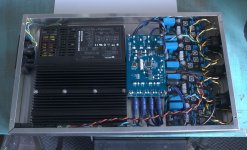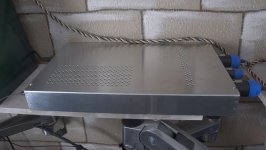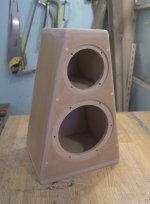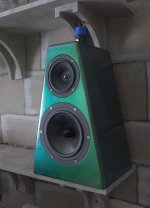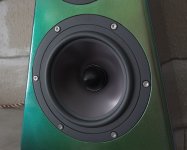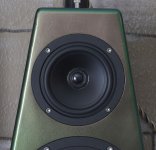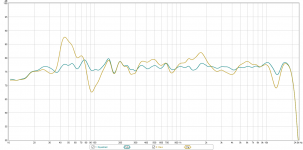I think this is probably the best place to post this, even though it's not only about speakers.
This project grew out of my desire to be less dependent on my PC as an audio source. I found that every time I changed the motherboard, the new one would handle bass management differently, so I couldn't always get my subwoofer set up right. With DSPs being the new thing, I thought I could use one to do all the things. I chose an Analog Devices ADAU1452 evaluation board due to the optical input and large number of analogue outputs. I coupled that with some cheap class-D amplifiers and a PSU that I snagged off eBay. Not a lot of DIY in the electronics, just off-the-shelf parts wired together.
The second part of this project is the speakers. With enough outputs from the DSP for 3-way speakers, I took the opportunity to experiment with coaxial drivers, which is something I have always wanted to do. I really wanted to get some 3-way coaxial drivers, but I couldn't get any. The closest I could find was the HiVi Trinity6, but it's more like a 2-way with added supertweeter than a real 3-way, plus it's unobtainable. So I looked into using a coaxial mid/tweeter and separate woofer.
Good coaxial drivers are quite rare. The best ones I could find were coaxial compression drivers, but they are really expensive, and the horns are too big. I ended up with the Dayton Audio CX120-8 (at the time of writing, these have disappeared from sale, leaving approxiamtely 0 good, cheap coaxial speakers available). Being very small, it avoids the problems of the cone interfering with the tweeter that most coaxial drivers have. I paired those with the Dayton Audio RS180-8 woofer.
I made the cabinets with sloping sides, mostly to make them look nicer than a plain box, but also to help spread out standing waves and increase stiffness. I'm glad I bought a router a few years ago, as it makes cutting such angles much easier, and I can now recess drivers flush with the front panel. I then sprayed them with fancy automotive paint. The cables stick out the top, which looks a bit funny, but allows the speakers to be pushed flat against the wall.
The subwoofer is the same enormous horn I was already using.
The DSP handles the crossover, with crossover points at 85Hz, 500Hz and 5kHz, all 4th order LR. It also applies EQ derived from measurements I took with Room EQ Wizard, resulting in a frequency response that is acceptably flat from 20Hz-20kHz. The frequency response chart attached below shows the response before and after EQ.
There are a few more photos and details on my website.
This project grew out of my desire to be less dependent on my PC as an audio source. I found that every time I changed the motherboard, the new one would handle bass management differently, so I couldn't always get my subwoofer set up right. With DSPs being the new thing, I thought I could use one to do all the things. I chose an Analog Devices ADAU1452 evaluation board due to the optical input and large number of analogue outputs. I coupled that with some cheap class-D amplifiers and a PSU that I snagged off eBay. Not a lot of DIY in the electronics, just off-the-shelf parts wired together.
The second part of this project is the speakers. With enough outputs from the DSP for 3-way speakers, I took the opportunity to experiment with coaxial drivers, which is something I have always wanted to do. I really wanted to get some 3-way coaxial drivers, but I couldn't get any. The closest I could find was the HiVi Trinity6, but it's more like a 2-way with added supertweeter than a real 3-way, plus it's unobtainable. So I looked into using a coaxial mid/tweeter and separate woofer.
Good coaxial drivers are quite rare. The best ones I could find were coaxial compression drivers, but they are really expensive, and the horns are too big. I ended up with the Dayton Audio CX120-8 (at the time of writing, these have disappeared from sale, leaving approxiamtely 0 good, cheap coaxial speakers available). Being very small, it avoids the problems of the cone interfering with the tweeter that most coaxial drivers have. I paired those with the Dayton Audio RS180-8 woofer.
I made the cabinets with sloping sides, mostly to make them look nicer than a plain box, but also to help spread out standing waves and increase stiffness. I'm glad I bought a router a few years ago, as it makes cutting such angles much easier, and I can now recess drivers flush with the front panel. I then sprayed them with fancy automotive paint. The cables stick out the top, which looks a bit funny, but allows the speakers to be pushed flat against the wall.
The subwoofer is the same enormous horn I was already using.
The DSP handles the crossover, with crossover points at 85Hz, 500Hz and 5kHz, all 4th order LR. It also applies EQ derived from measurements I took with Room EQ Wizard, resulting in a frequency response that is acceptably flat from 20Hz-20kHz. The frequency response chart attached below shows the response before and after EQ.
There are a few more photos and details on my website.
Attachments
^I was thinking the same, looks like listening spot and long gate?
There might be too much eq for room modes and first reflections - 45Hz is 10dB down and 90Hs almost 10dB up.
What is causing the hump at 1,8kHz? Did you eq each driver separately or the whole system? Eq-ing each driver to get good acoustic slopes and taming resonances is very important. Room eq is secondary and negotiable.
There might be too much eq for room modes and first reflections - 45Hz is 10dB down and 90Hs almost 10dB up.
What is causing the hump at 1,8kHz? Did you eq each driver separately or the whole system? Eq-ing each driver to get good acoustic slopes and taming resonances is very important. Room eq is secondary and negotiable.
I'm pleased with them. I don't like providing too much subjective opinion because I'm biased, but one thing that seems to have worked is that I no longer notice as much that the speakers are positioned above me. With my old speakers, even if I closed my eyes, everything always sound like it came from up there, which it did of course. With the new ones, that wrong sense of height is reduced.This project looks interesting, I was interested in a coaxial like the Dayton, can you tell us how does yours sound?
0.5 metres, on-axis, with the speakers in their actual location, with a frequency sweep in REW.Very nice looking! But curious how you are measuring. Near field? In place?
Best,
E
The 1.8kHz hump comes from the mid. You can see it in the specs, and it was worse in the measurments I took, though the other channel was not as bad as the one you can see here. I applied EQ for each whole channel rather than per-driver.^I was thinking the same, looks like listening spot and long gate?
There might be too much eq for room modes and first reflections - 45Hz is 10dB down and 90Hs almost 10dB up.
What is causing the hump at 1,8kHz? Did you eq each driver separately or the whole system? Eq-ing each driver to get good acoustic slopes and taming resonances is very important. Room eq is secondary and negotiable.
I ended up with the Dayton Audio CX120-8 (at the time of writing, these have disappeared from sale, leaving approxiamtely 0 good, cheap coaxial speakers available). Being very small, it avoids the problems of the cone interfering with the tweeter that most coaxial drivers have.on my website.
Can you Please say something more about Dayton Audio CX120-8 . Individually how the tweeter and the midrange perform in terms of quality.
I am planing to buy it. Its costing approx $50 each.
Apparently there was an issue with the first lot of the Dayton Coaxials in that the voice coil was perforated. This allowed air to chuff around the tweeter.
This was supposedly fixed in later units, which could explain why stock went down to zero initially.
For a midrange application this isn't going to be much of a problem though.
This was supposedly fixed in later units, which could explain why stock went down to zero initially.
For a midrange application this isn't going to be much of a problem though.
I've bought those chip-amp's few years ago to give them a try. For that price it is surprising that they work but vocals sounded really bad compared to few other amplifiers i had in A/B test - and i was listening quite low in level. If the sound is good now, then i know it can be upgraded by quite a margin with better amplification - at least in the mid-hi region.
Last edited:
There's not a lot to say about them really. The tweeter is exactly the size I like them - small enough to go all the way up to 20kHz with good dispersion. The mid seems to have low distortion. Together as whole speakers, the imaging is among the best of anything I've ever heard, presumably a benefit of their coaxial nature. I can definitely recommend them.Can you Please say something more about Dayton Audio CX120-8 . Individually how the tweeter and the midrange perform in terms of quality.
I am planing to buy it. Its costing approx $50 each.
To follow on from what I wrote there - after a bit of experimentation, I worked out that the difference was mostly due to the position of the mids at the top of the speakers, compared to the old ones where the midrange was partly produced by the woofer at the bottom. Combined with the top of my PC's monitors close to the bottom of the speakers, this produced diffraction with the old speakers but less with the new ones....With my old speakers, even if I closed my eyes, everything always sound like it came from up there, which it did of course...
There's not a lot to say about them really. The tweeter is exactly the size I like them - small enough to go all the way up to 20kHz with good dispersion. The mid seems to have low distortion. Together as whole speakers, the imaging is among the best of anything I've ever heard, presumably a benefit of their coaxial nature. I can definitely recommend them.
Thanks,
I ordered a pair.
- Status
- This old topic is closed. If you want to reopen this topic, contact a moderator using the "Report Post" button.
- Home
- Loudspeakers
- Multi-Way
- Coaxial Speakers With DSP
